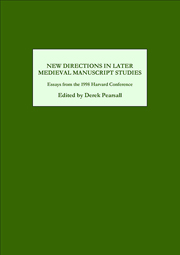Book contents
- Frontmatter
- Contents
- List of Illustrations
- Acknowledgements
- Introduction
- Recent Directions in Medieval Manuscript Study
- Another Fine Manuscript Mess: Authors, Editors and Readers of Piers Plowman
- A New Approach to the Witnesses and Text of the Canterbury Tales
- Prospecting in the Archives: Middle English Verse in Record Repositories
- Medieval Manuscripts and Electronic Media: Observations on Future Possibilities
- Representing the Middle English Manuscript
- Skins, Sheets and Quires
- Reconsidering the Auchinleck Manuscript
- Professional Readers of Langland at Home and Abroad: New Directions in the Political and Bureaucratic Codicology of Piers Plowman
- Professional Scribes? Identifying English Scribes Who Had a Hand in More Than One Manuscript
- Manuscript Production in Medieval Theatre: The German Carnival Plays
- The ‘Lancelot-Graal’ Project
- After Chaucer: Resituating Middle English Poetry in the Late Medieval and Early Modern Period
- Notes on Contributors
- Index
Professional Scribes? Identifying English Scribes Who Had a Hand in More Than One Manuscript
Published online by Cambridge University Press: 05 September 2014
- Frontmatter
- Contents
- List of Illustrations
- Acknowledgements
- Introduction
- Recent Directions in Medieval Manuscript Study
- Another Fine Manuscript Mess: Authors, Editors and Readers of Piers Plowman
- A New Approach to the Witnesses and Text of the Canterbury Tales
- Prospecting in the Archives: Middle English Verse in Record Repositories
- Medieval Manuscripts and Electronic Media: Observations on Future Possibilities
- Representing the Middle English Manuscript
- Skins, Sheets and Quires
- Reconsidering the Auchinleck Manuscript
- Professional Readers of Langland at Home and Abroad: New Directions in the Political and Bureaucratic Codicology of Piers Plowman
- Professional Scribes? Identifying English Scribes Who Had a Hand in More Than One Manuscript
- Manuscript Production in Medieval Theatre: The German Carnival Plays
- The ‘Lancelot-Graal’ Project
- After Chaucer: Resituating Middle English Poetry in the Late Medieval and Early Modern Period
- Notes on Contributors
- Index
Summary
John Shirley, Thomas Hoccleve, John Capgrave, Stephen Doddesham, the ‘Ellesmere-Hengwrt scribe’, the ‘Hammond scribe’, the ‘Edmund-Fremund scribe’, the ‘hooked-g scribe’, ‘Doyle and Parkes's scribe D’ are only a few of the scribes whose hands have been found in more than one medieval English manuscript. Identification of these hands began in the nineteenth century. In the twentieth century, the volume of scholarly activity focussed on identification of hands has increased almost without interruption to the present day, as ease of transportation, greater accessibility to libraries, lower costs of photo-reproduction and new technologies have made it easier – though never easy – to compare hands in manuscripts now scattered worldwide. This activity is bound to increase still more now that digital image technology has made reproductions of medieval manuscripts substantially more accurate than before and electronic media have made them substantially more accessible. In this paper I shall try to give an overview of the discoveries made to date in this field, many of them by contributors to this volume: I shall describe the confusions that have arisen from inaccurate and misleading identifications made in the past, and the advances in our knowledge about medieval manuscript production and distribution that have resulted from more recent, accurate identifications. I shall end with my ideas about new directions for this field of medieval manuscript study.
To get a sense of where we are with this line of enquiry, it is necessary to look back to the work of scholars in the past upon whose foundations we are building. How much more difficult was the identification of hands in the nineteenth century is illustrated by misidentifications upon which scholars relied and which scholars repeated for decades before correction.
- Type
- Chapter
- Information
- New Directions in Later Medieval Manuscript StudiesEssays from the 1998 Harvard Conference, pp. 131 - 142Publisher: Boydell & BrewerPrint publication year: 2000



